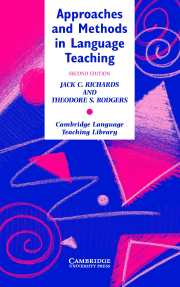Book contents
- Frontmatter
- Contents
- Preface
- Part I Major language trends in twentieth-century language teaching
- 1 A brief history of language teaching
- 2 The nature of approaches and methods in language teaching
- 3 The Oral Approach and Situational Language Teaching
- 4 The Audiolingual Method
- Part II Alternative approaches and methods
- Part III Current communicative approaches
- Author index
- Subject index
3 - The Oral Approach and Situational Language Teaching
Published online by Cambridge University Press: 06 July 2010
- Frontmatter
- Contents
- Preface
- Part I Major language trends in twentieth-century language teaching
- 1 A brief history of language teaching
- 2 The nature of approaches and methods in language teaching
- 3 The Oral Approach and Situational Language Teaching
- 4 The Audiolingual Method
- Part II Alternative approaches and methods
- Part III Current communicative approaches
- Author index
- Subject index
Summary
Few language teachers today are familiar with the terms Oral Approach or Situational Language Teaching, which refer to an approach to language teaching developed by British applied linguists from the 1930s to the 1960s. Even though neither term is commonly used today, the impact of the Oral Approach has been long-lasting, and it has shaped the design of many widely used EFL/ESL textbooks and courses, including many still being used today. One of the most successful ESL courses published, Streamline English (Hartley and Viney 1978), reflected the classic principles of Situational Language Teaching, as did many other series that have been widely used (e.g., Access to English, Coles and Lord 1975; Kernel Lessons Plus, O'Neill 1973; and many of L. G. Alexander's widely used textbooks, e.g., Alexander 1967). Hubbard, Jones, Thornton, and Wheeler's comment in 1983 still holds true today: “This method is widely used at the time of writing and a very large number of textbooks are based on it” (Hubbard et al. 1983: 36). It is important, therefore, to understand the principles and practices of the Oral Approach and Situational Language Teaching.
Background
The origins of this approach began with the work of British applied linguists in the 1920s and 1930s. Beginning at this time, a number of outstanding applied linguists developed the basis for a principled approach to methodology in language teaching. Two of the leaders in this movement were Harold Palmer and A. S. Hornby, two of the most prominent figures in British twentieth-century language teaching. Both were familiar with the work of such linguists as Otto Jespersen and Daniel Jones, as well as with the Direct Method.
- Type
- Chapter
- Information
- Approaches and Methods in Language Teaching , pp. 36 - 49Publisher: Cambridge University PressPrint publication year: 2001



